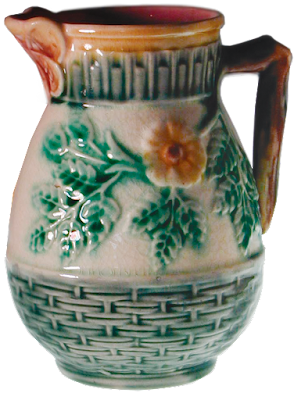Fan ice cream clatter with six plates.
Recently, there has been a scholarly challenge to this attribution by Dr. Laura Microulis of Bard University who has theorized that these fan wares were not made by Eureka but by Willets Manufacturing Company, a neighboring Trenton pottery. This theory is based largely on an advertisement for fan wares made Willets Excelsior Pottery that appeared in 1882 for the company. We outlined this in a previous post. The matter seemed to be settled by this new scholarship, however, it was still at odds with another theory on the attribution of these fan dishes—that they were English in origin.
It is well known that a series of similar round plates and tea sets were made by the British pottery of Shorter and Boulton, yet to the best of my knowledge this company has never been associated with these fan dishes. Recently I photographed one of these fan ice cream dishes with an English Diamond Registration mark—for March 1881—on the reverse. The design is registered to Shorter and Boulton, a year before the Willets advertisement.
 |
| Willeets ad for Fan wares |
 |
| English Registration mark for March 17, 1881 |
I should say that the presence of this new design attribution throws a bit of a monkey wrench into our assumptions about this design as American but does not necessarily destroy everything we know about the pieces. After all, it was common practice for companies to copy designs from each other. In fact we have illustrated such copies in this blog, and it was especially common for American companies to copy pieces from elsewhere. The Etruscan Works of Phoenixville, PA was notorious for reproducing numerous Wedgwood designs among its earliest work. Still, it does force us to reevaluate the origin of this clever and popular fan design.
| Wedgwood cricket jug on the left and the American copy on the right
Given this information we have no choice but to conclude that this fan design was an original Shorter & Boulton design that was copied by American potters. This actually makes much more sense than attributing the fan design to any American pottery. The Shorter & Boulton fan series is large and consistent. All the pieces have small flowering Prunus branches and most have a pebbled sharkskin ground. The bird found on the double fan platter is repeated again and again on hollowware pieces of different types. It makes for a cohesive overall look for the pattern. [For a quick purview of Shorter & Boulton’s known fan wares look here.] While the different components were copied and reworked by smaller potteries they never work better than they do here. We do not know how long these designs remained in production at Shorter & Boulton. Unless further study proves otherwise the design origin must now be considered English. |
























































